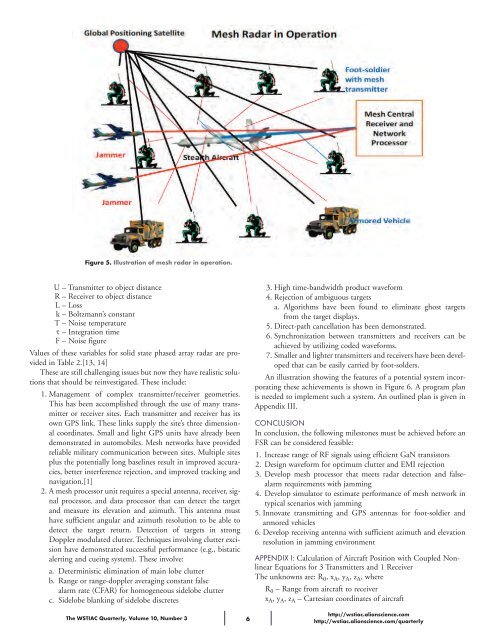Article: Forward Scatter Radar for Future Systems
Article: Forward Scatter Radar for Future Systems
Article: Forward Scatter Radar for Future Systems
You also want an ePaper? Increase the reach of your titles
YUMPU automatically turns print PDFs into web optimized ePapers that Google loves.
Figure 5. Illustration of mesh radar in operation.<br />
U – Transmitter to object distance<br />
R – Receiver to object distance<br />
L – Loss<br />
k – Boltzmann’s constant<br />
T – Noise temperature<br />
τ – Integration time<br />
F – Noise figure<br />
Values of these variables <strong>for</strong> solid state phased array radar are provided<br />
in Table 2.[13, 14]<br />
These are still challenging issues but now they have realistic solutions<br />
that should be reinvestigated. These include:<br />
1. Management of complex transmitter/receiver geometries.<br />
This has been accomplished through the use of many transmitter<br />
or receiver sites. Each transmitter and receiver has its<br />
own GPS link. These links supply the site’s three dimensional<br />
coordinates. Small and light GPS units have already been<br />
demonstrated in automobiles. Mesh networks have provided<br />
reliable military communication between sites. Multiple sites<br />
plus the potentially long baselines result in improved accuracies,<br />
better interference rejection, and improved tracking and<br />
navigation.[1]<br />
2. A mesh processor unit requires a special antenna, receiver, signal<br />
processor, and data processor that can detect the target<br />
and measure its elevation and azimuth. This antenna must<br />
have sufficient angular and azimuth resolution to be able to<br />
detect the target return. Detection of targets in strong<br />
Doppler modulated clutter. Techniques involving clutter excision<br />
have demonstrated successful per<strong>for</strong>mance (e.g., bistatic<br />
alerting and cueing system). These involve:<br />
a. Deterministic elimination of main lobe clutter<br />
b. Range or range-doppler averaging constant false<br />
alarm rate (CFAR) <strong>for</strong> homogeneous sidelobe clutter<br />
c. Sidelobe blanking of sidelobe discretes<br />
The WSTIAC Quarterly, Volume 10, Number 3 6<br />
3. High time-bandwidth product wave<strong>for</strong>m<br />
4. Rejection of ambiguous targets<br />
a. Algorithms have been found to eliminate ghost targets<br />
from the target displays.<br />
5. Direct-path cancellation has been demonstrated.<br />
6. Synchronization between transmitters and receivers can be<br />
achieved by utilizing coded wave<strong>for</strong>ms.<br />
7. Smaller and lighter transmitters and receivers have been developed<br />
that can be easily carried by foot-solders.<br />
An illustration showing the features of a potential system incorporating<br />
these achievements is shown in Figure 6. A program plan<br />
is needed to implement such a system. An outlined plan is given in<br />
Appendix III.<br />
CONCLUSION<br />
In conclusion, the following milestones must be achieved be<strong>for</strong>e an<br />
FSR can be considered feasible:<br />
1. Increase range of RF signals using efficient GaN transistors<br />
2. Design wave<strong>for</strong>m <strong>for</strong> optimum clutter and EMI rejection<br />
3. Develop mesh processor that meets radar detection and falsealarm<br />
requirements with jamming<br />
4. Develop simulator to estimate per<strong>for</strong>mance of mesh network in<br />
typical scenarios with jamming<br />
5. Innovate transmitting and GPS antennas <strong>for</strong> foot-soldier and<br />
armored vehicles<br />
6. Develop receiving antenna with sufficient azimuth and elevation<br />
resolution in jamming environment<br />
APPENDIX I: Calculation of Aircraft Position with Coupled Nonlinear<br />
Equations <strong>for</strong> 3 Transmitters and 1 Receiver<br />
The unknowns are: R0, xA, yA, zA, where<br />
R0 – Range from aircraft to receiver<br />
xA, yA, zA – Cartesian coordinates of aircraft<br />
http://wstiac.alionscience.com<br />
http://wstiac.alionscience.com/quarterly




